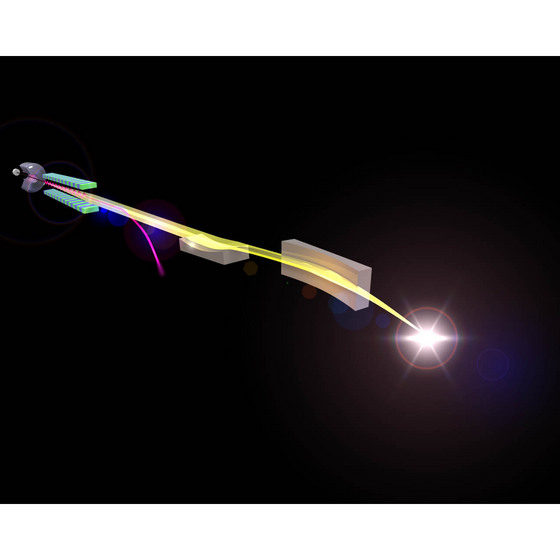Home > Press > X-ray lasers in focus: A new large high-precision mirror is capable of focusing x-ray radiation to spot sizes of just a few nanometers
 |
| Figure 1: Schematic showing the position of the mirror in the x-ray free electron laser setup. |
Abstract:
Radiation from x-ray lasers such as x-ray free electron lasers are of wide interest, as they will allow a large number of applications such as the study of the structure of single molecules. However, for such applications to be realized, the x-rays need to be strongly focused at the nanoscale. Researchers from the RIKEN Advanced Science Institute in Wako, collaborating with researchers from Osaka University and the Japan Synchrotron Radiation Research Institute (JASRI), have now developed a mirror suitable for this task.
X-ray lasers in focus: A new large high-precision mirror is capable of focusing x-ray radiation to spot sizes of just a few nanometers
Japan | Posted on November 28th, 2008High-energy x-ray radiation is very damaging, so mirrors with curved surfaces are used in the focusing of x-rays to minimize penetration into imaging devices. As an incident laser beam reaches a mirror at a very small angle, a mirror surface of 400 mm in length is needed to collect all light from the laser (Fig. 1). The researchers recently published the details of their successful fabrication of the first such large-scale mirror—capable of focusing x-rays down to the theoretical limit at the nanoscale—in the journal Review of Scientific Instruments1.
The material of choice for this mirror was silicon. Being a relatively light element, it absorbs x-rays only weakly, meaning less long-term damage to the mirror. As any imperfections can have a significant impact on imaging quality, the researchers ensured the surface was perfect. According to Hitoshi Ohmori, who led the efforts at RIKEN, "the key advance in the fabrication of this mirror is the achievement of an ultra-smooth surface in combination with such a large mirror size."
The highly polished mirror surface was achieved in a two-step procedure. First, the researchers used the high-precision grinding technique, called electrolytic in-process dressing (ELID), to obtain a height precision across the mirror of about 100 nm. Then they used the ultra-precise elastic emission machining (EEM) process, which is based on chemical reactions between the silicon surface and micron-sized abrasive particles. Overall, a precision of 2 nm was achieved across the entire 400 mm long mirror, corresponding to a height precision of 2 mm over a length roughly the distance between Tokyo and Osaka (approximately 400 km).
In the first performance tests, the researchers used the mirror to focus a 15 keV x-ray beam from the SPring-8 facility to a spot size of 75 nm—almost equal to the theoretical limit that a perfect mirror can achieve. The aim now, Ohmori emphasizes, is to perfect this technology to offer a scalable and efficient process to fabricate x-ray mirror optics.
Reference
1. Mimura, H., Morita, S., Kimura, T., Yamakawa, D., Lin, W., Uehara, Y., Matsuyama, H., Yumoto, H., Ohashi, H.., Tamasaku, K. et al. Focusing mirror for x-ray free-electron lasers. Review of Scientific Instruments 79, 083104 (2008).
The corresponding author for this highlight is based at the RIKEN Materials Fabrication Laboratory
####
For more information, please click here
Copyright © Riken
If you have a comment, please Contact us.Issuers of news releases, not 7th Wave, Inc. or Nanotechnology Now, are solely responsible for the accuracy of the content.
| Related Links |
| Related News Press |
News and information
![]() Researchers develop molecular qubits that communicate at telecom frequencies October 3rd, 2025
Researchers develop molecular qubits that communicate at telecom frequencies October 3rd, 2025
![]() Next-generation quantum communication October 3rd, 2025
Next-generation quantum communication October 3rd, 2025
![]() "Nanoreactor" cage uses visible light for catalytic and ultra-selective cross-cycloadditions October 3rd, 2025
"Nanoreactor" cage uses visible light for catalytic and ultra-selective cross-cycloadditions October 3rd, 2025
Discoveries
![]() Researchers develop molecular qubits that communicate at telecom frequencies October 3rd, 2025
Researchers develop molecular qubits that communicate at telecom frequencies October 3rd, 2025
![]() Next-generation quantum communication October 3rd, 2025
Next-generation quantum communication October 3rd, 2025
![]() "Nanoreactor" cage uses visible light for catalytic and ultra-selective cross-cycloadditions October 3rd, 2025
"Nanoreactor" cage uses visible light for catalytic and ultra-selective cross-cycloadditions October 3rd, 2025
Announcements
![]() Rice membrane extracts lithium from brines with greater speed, less waste October 3rd, 2025
Rice membrane extracts lithium from brines with greater speed, less waste October 3rd, 2025
![]() Researchers develop molecular qubits that communicate at telecom frequencies October 3rd, 2025
Researchers develop molecular qubits that communicate at telecom frequencies October 3rd, 2025
![]() Next-generation quantum communication October 3rd, 2025
Next-generation quantum communication October 3rd, 2025
![]() "Nanoreactor" cage uses visible light for catalytic and ultra-selective cross-cycloadditions October 3rd, 2025
"Nanoreactor" cage uses visible light for catalytic and ultra-selective cross-cycloadditions October 3rd, 2025
Photonics/Optics/Lasers
![]() ICFO researchers overcome long-standing bottleneck in single photon detection with twisted 2D materials August 8th, 2025
ICFO researchers overcome long-standing bottleneck in single photon detection with twisted 2D materials August 8th, 2025
![]() Institute for Nanoscience hosts annual proposal planning meeting May 16th, 2025
Institute for Nanoscience hosts annual proposal planning meeting May 16th, 2025
|
|
||
|
|
||
| The latest news from around the world, FREE | ||
|
|
||
|
|
||
| Premium Products | ||
|
|
||
|
Only the news you want to read!
Learn More |
||
|
|
||
|
Full-service, expert consulting
Learn More |
||
|
|
||








